The new Dominator Platinum RGB series Corsair offers a range of DDR4 solutions that combine high performance with a unique design. The use of the new RGB LED Hairx, a new feature of the American company, increases the brightness with much smaller dimensions and better energy efficiency.
They were announced at the CES 2019 in Las Vegas, at the beginning of January: we are talking about the new Corsair Dominator Platinum RGB memories, solutions that represent the new proposal of the American company for the higher end market. In fact, these are memories aimed at those passionate users who are looking for a solution capable of ensuring very high clock frequencies but at the same time wanting a very apparent visual connotation.
The heart of these memories is an aluminum structure that surrounds them completely, enriched by the integration of 12 LEDs that can be managed independently. These are the new LEDs of the series Capellix RGB, presented by Corsair at CES 2019 and will be progressively used in various products of the company. Their peculiarity is that they have a construction that leads to a much smaller footprint than the typical RGB LEDs adopted in the peripheral devices on the market, but offering a higher intensity of illumination. In addition to the LEDs, the new memories integrate real-time monitoring systems for their clock frequency and operating temperature.
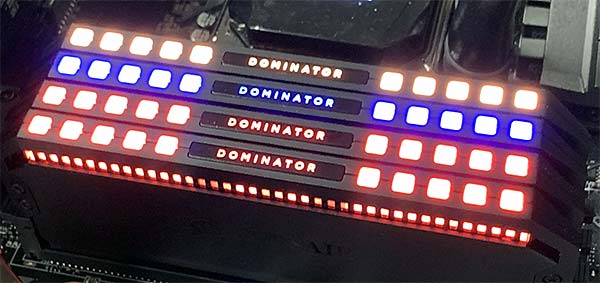
The modules are built using a 10-layer PCB, using the Dual-Channel DHX Cooling technology developed by Corsair for its memories: it provides a heat sink integrated directly into the module PCB, able to transfer heat away from memory chips. It is a useful feature both with default settings and when intervening in overvolt to ensure a better margin of success with overclocked operating frequencies.
The LEDs are integrated in the upper part of the modules, divided into two blocks of 5; two LEDs are intended for illumination of the central part, on which Dominator stands out. This is the area that differentiates the new Dominator memories from the previous generation of Corsair models belonging to the same family.
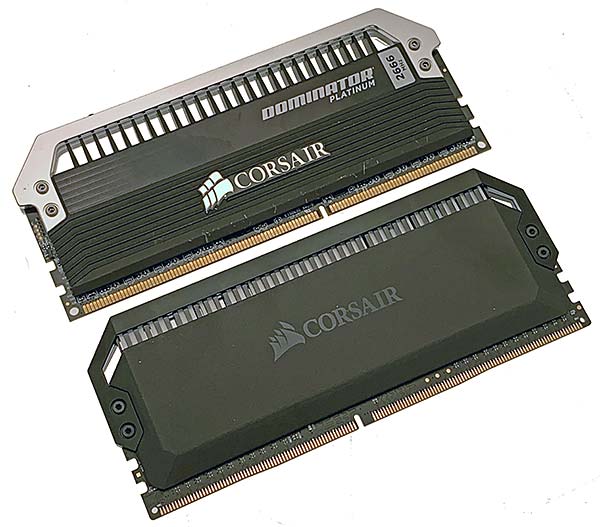
The LED Hairx, as mentioned, have the peculiarity of having a much smaller footprint than those typically used in IT products. Result of a collaboration with the Taiwanese company Primax, the Capellix technology allows to mount the LED substrate directly on the PCB, thus being able to do without the containment package. In this way LEDs are obtained that have a volume of 0.2 cubic millimeters against the 2.8 mm cubes typical of the traditional LED, with positive effects in terms of higher illumination intensity and energy efficiency.
Corsair iCUE software is the control center of the LED system of Dominator Platinum RGB memories: it allows, through a practical graphical interface, to select predefined patterns for lighting the modules or to prepare the preferred one in a completely manual way. Each of the 12 LED Hairx can be programmed by software, generating an almost infinite number of potential color combinations.
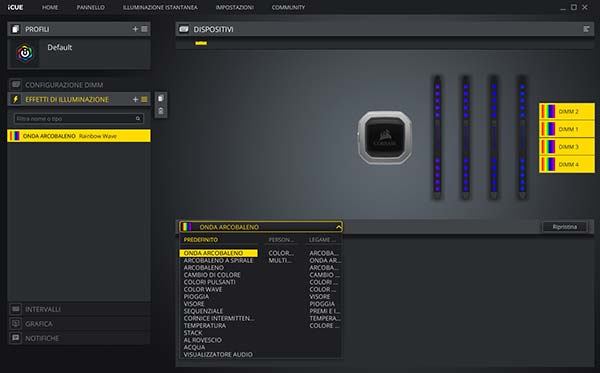
From the software it is possible not only to pilot the operation of the LEDs but also to keep under control some parameters of operation of the memories: from the clock frequency to the timings set by bios, up to the temperature of the single modules that is constantly monitored through a log.
Dominator Platinum RGB memories are offered in different combinations of modules and specifications; Corsair proposes as many as 22 different versions, in kit of 2, 4 or 8 modules for a total capacity ranging from a minimum of 16 up to a maximum of 128 GB. The clock frequencies start at a value of 3200 MHz up to 4800 MHz for a 16 GB dual channel kit. Obviously also the access latencies vary, which can be more or less pushed for the same certified clock frequency with values of CL starting from a minimum of 14 up to 19 in the kits with a higher clock.
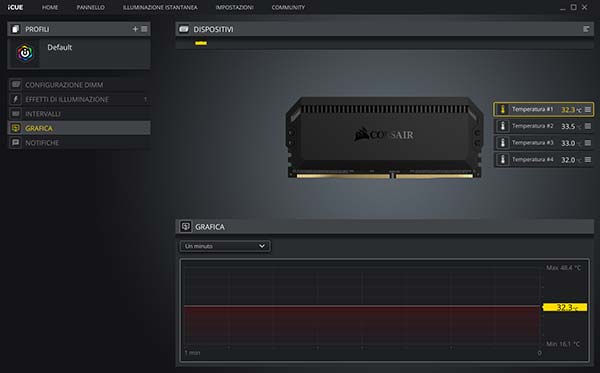
We had a 32 Gbytes certified quad channel memory kit at 3600 MHz clock, with timings of 16-18-18-36 at the power supply of 1.35V. These are memories sold at a recommended price of $570 including VAT, a figure certainly not contained in absolute terms but that we found to be in line with what was required in Italy for Corsair Dominator Platinum kits of similar technical characteristics.
With the same clock frequency and access timings, DDR4 memories actually operate all providing the same performance. The use of a kit with a frequency higher than that of the specifications, as in the case of this 3600 MHz clock Dominator Platinum RGB, allows to obtain a behavior of the memories already very valid as the latency is maintained on parameters contained overall. We performed some scalability tests, intervening from bios on the memory frequency multiplier in combination with progressively more advanced timings and carrying, where required, the power supply voltage of the memory up to 1.4V. The goal was to understand which the maximum clock frequency was supported with particular combinations of timings and supply voltage …
- Clock 3600 MHz, timings 16-18-18-36, voltage 1.35V
- Clock 3700 MHz, timings 16-18-18-36, voltage 1.35V
- Clock 3733 MHz, timings 16-18-18-36, voltage 1.35V
- Clock 3800 MHz, timings 16-18-18-36, voltage 1.35V
- Clock 3866 MHz, timings 16-18-18-36, voltage 1.35V
- Clock 3900 MHz, timings 17-18-18-36, voltage 1.40V
- Clock 4000 MHz, timings 17-18-18-36, voltage 1.40V
- Clock 4100 MHz, timings 19-19-19-39, voltage 1.40V
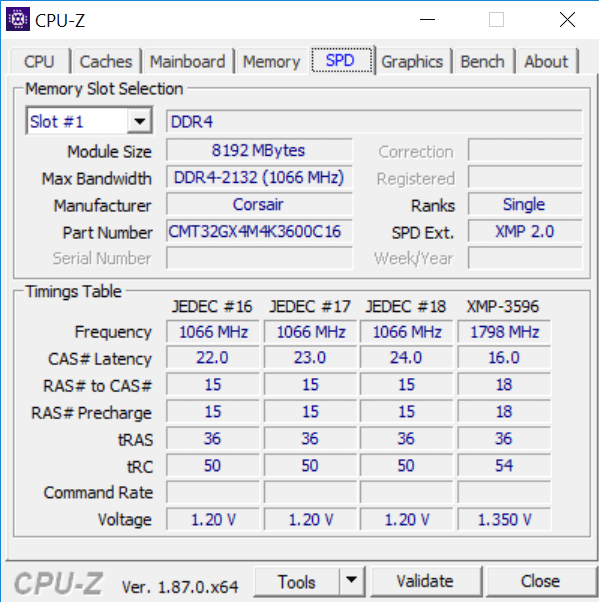
The transition from the default 3.6 GHz up to 4.1 GHz of the maximum overclock represents a big leap forward in terms of memory bandwidth, although this also requires intervening on access timings that are more conservative at the frequency of maximum clock. Also the supply voltage has been increased, going from 1.35V default up to 1.4V.
The result is therefore much more interesting at the clock frequency of 3866 MHz, a value that has allowed to maintain voltage and timings by default and therefore maximize the overall performance of these memories compared to the already high frequency of 3600 MHz series. These results are were obtained using 4 memory modules in a configuration with an Intel Core i9-9900K processor mounted on MSI Z370 Tomahawk motherboard. The success in overclock of this range is obviously linked to the specific modules used and to the combination of motherboard and processor. In general, with this certified 3600 MHz kit there is no margin to get good overclocking results, obviously for those who are not satisfied with the standard settings.
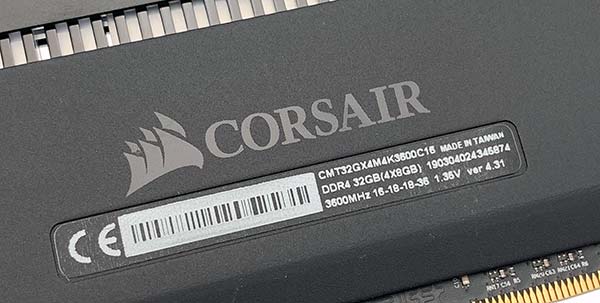
With the Dominator Platinum RGB memories, Corsair relaunches its DDR4 series of solutions, offering very varied options including total quantity of memory, number of modules and technical specifications. The Capellix LEDs are the main novelty: it is an interesting technical solution, able to offer a superior brightness compared to standard LEDs. This may or may not suit depending on personal preferences towards RGB LEDs in PCs, but it is clear that the lighting of components is a trend taken forward by producers in a direct and firm way.
Once the LEDs have been removed, the Dominator Platinum RGB memories confirm the quality of Corsair in the construction, offering more than valid configuration options between quantities, timings and certified clock frequencies in order to satisfy any type of need.


